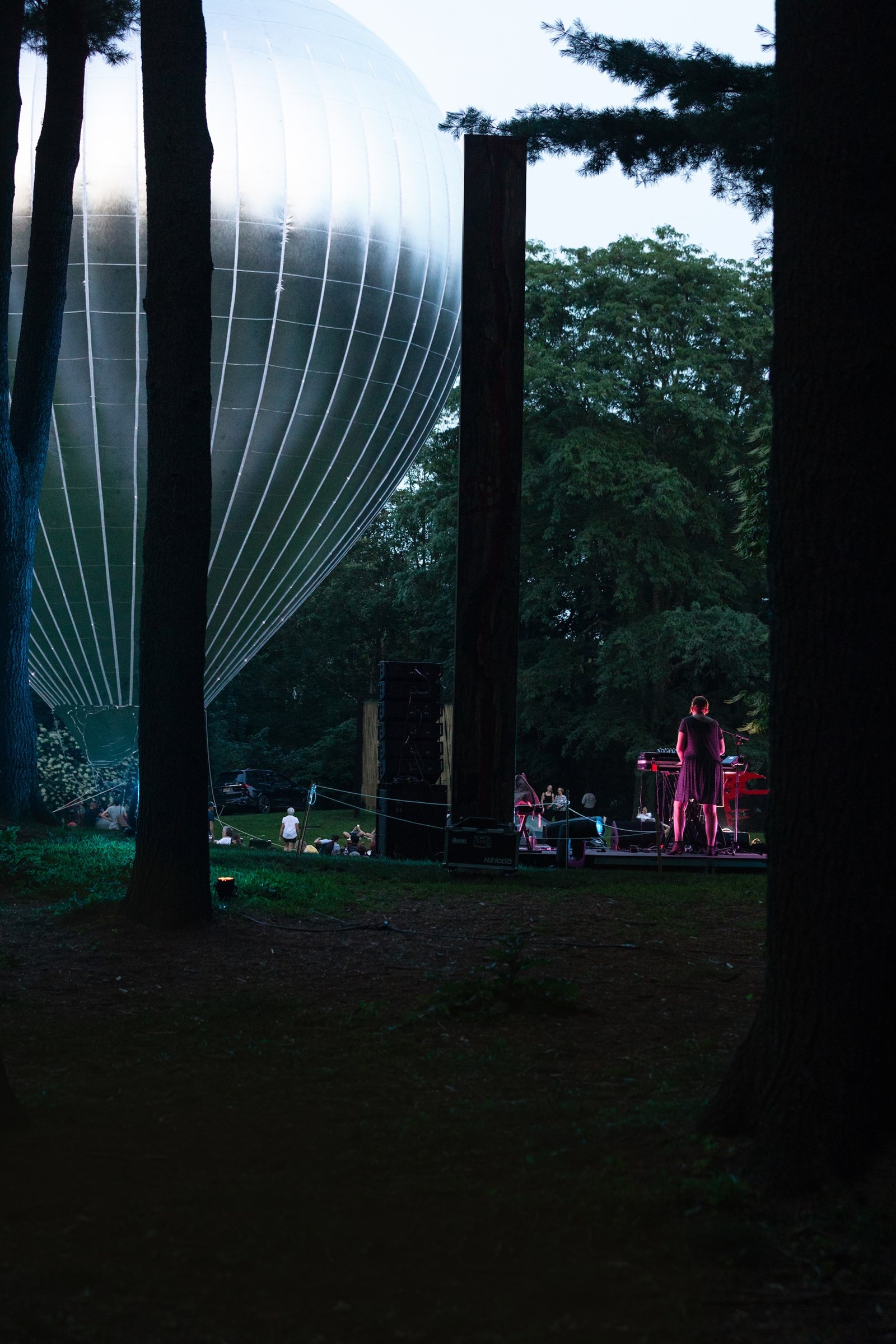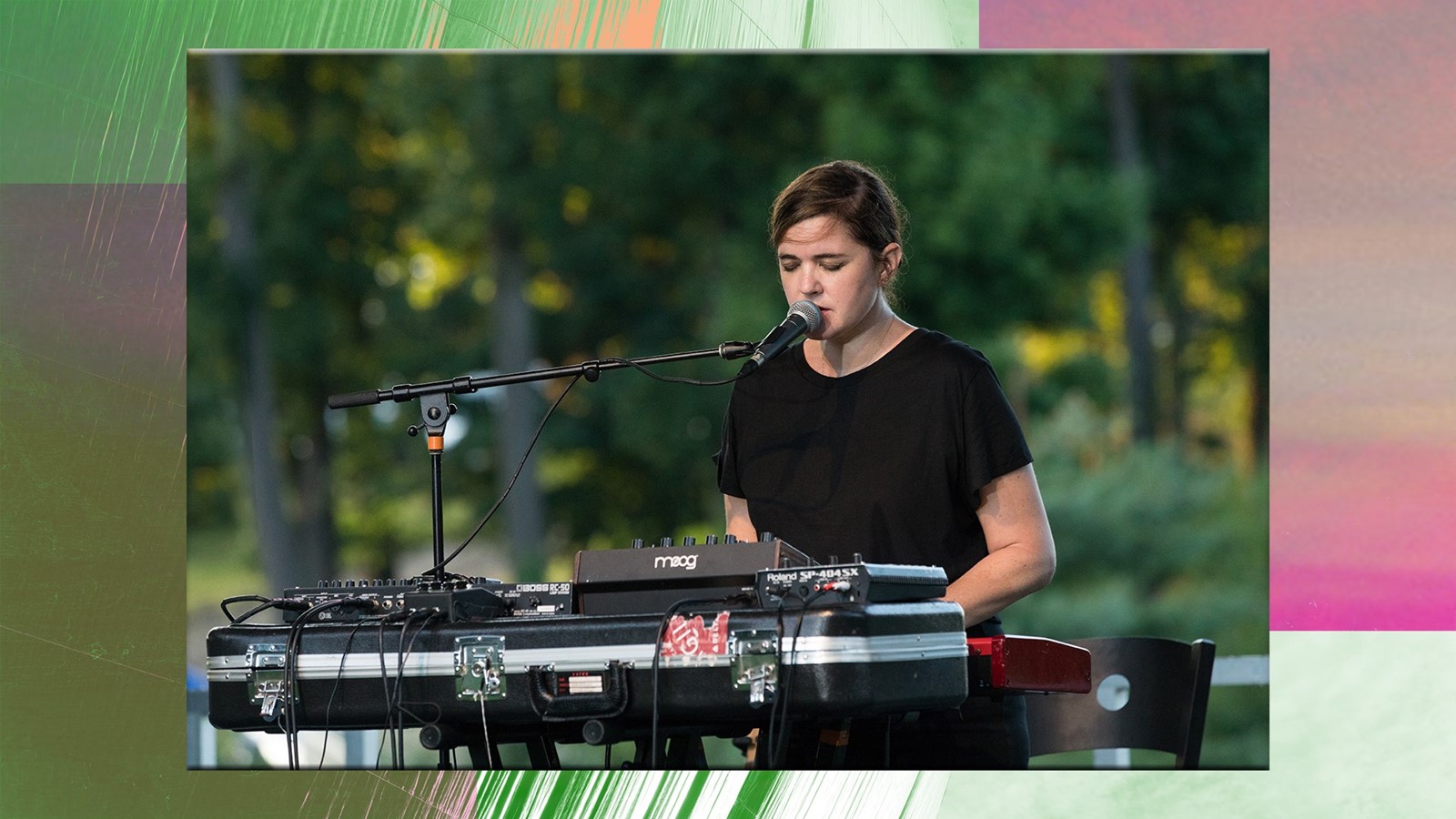Following her performances as part of Doug Aitken’s New Horizon project, the electronic composer discusses finding peace in the wild
The idea was this: to launch a 100-foot reflective hot air balloon through the skies of Massachusetts, touching down at six points across a period of nearly three weeks, starting on Martha’s Vineyard island off Cape Cod, and landing in Williamstown via Boston. Doug Aitken’s New Horizon nomadic art project was bound to be a spectacle, a self-described “road trip to the future” wrapped in mylar, floating between the clouds.
With live music shows and talks by the world’s leading climate experts dotted across each location, it’s unsurprising that Aitken chose ambient artist Julianna Barwick to perform at three of the six venues. Her music, an often-wordless configuration of layering and looping, sounds how I’d imagine floating in the air to feel like: an immeasurable vastness of ethereal rhythms and textures without a set beginning or end, kind of like a road trip.
Back in June, the Brooklyn-based artist tried her hand at creating the world’s first-ever interactive lobby score, using a camera situated on the roof of Sister City hotel in Manhattan to track stimuli or visual information, which was then used to determine which of Barwick’s pre-recorded tracks to play in the lobby.
As well as giving way to headline-friendly pieces (“Julianna Barwick is using the New York sky to make music,” read one article by the New Yorker), what both projects have in common is that they both touch on the idea of music in transit, popularised, of course, by Brian Eno’s 1978 Ambient 1: Music for Airports. With the balloon now back on the ground, we speak to Barwick about her experiences on New Horizon, her favourite road trips, and the future of creativity.

What was your role in Doug Aitken’s New Horizon? How did you get involved?
Julianna Barwick: I was one of the performers. There was one weekend where I was asked to do three shows in a weekend, so you could say I was the only repeat offender. My friend Zach Tetreault, who is the founder of FORM festival and Arcosanti, we’re really old friends, and he’s the sort of person that picked the artist for the event, with Doug’s approval, of course.
No one’s really structured a performance around a hot air balloon before, what did you think of it?
Julianna Barwick: I already knew that Doug was a really cool artist and I thought the idea was really fun and unique. I’ve always loved to see what visual artists come up with and this just seemed like a really unlikely event to come through, so to be part of it was really exciting, though initially I thought I’d be playing in the balloon.
I totally thought the same and I was a bit disappointed when I found out you weren’t.
Julianna Barwick: Same! I knew I wasn’t going to be 100 feet in the air, I thought it would be kind of floating, but that didn’t end up happening. There were two stages at two different venues, one was a sculpture park and the second was this estate that looked like something out of Eyes Wide Shut, it was epic.
That sounds mad. When I was reading about the hot air balloon and how its canvas is constantly changing, I saw parallels with your work on Sister City – I suppose that was sonically reacting to the natural world, just as the balloon is visually.
Julianna Barwick: It wasn’t something I was constantly thinking of but that’s one of the things I really love about this project and other things I’ve been asked to do. I find that the sort of music I make, because it’s mostly wordless, is susceptible to these unique visions and experiments.
I find the idea of music for transit really interesting, like how your Sister City project was inspired by Brian Eno’s Music for Airports, but New Horizon also sees the pairing of music and travel, only the people are static and the balloon is moving.
Julianna Barwick: I mean the balloon was kind of the star of the show. Actually, it was totally the star of the show, so we were the supporting acts. It really was magical and beautiful especially in those settings.
“The balloon was kind of the star of the show. Actually, it was totally the star of the show, so we were the supporting acts” – Julianna Barwick
Doug mentioned this idea of a road trip a lot when describing the project. Is there an iconic road trip that has left a lasting impression on you?
Julianna Barwick: I went to Iceland to make a record, Nepenthe, which came out in 2013, and that was so epic in so many different ways. All of my stuff before that was like bedroom recordings, so this was going to work with someone I admired in Iceland, Alex Somers (visual artist and producer), which is one of the most awe-inspiring, magical places on earth. I made all of the music when I was there.
In hindsight, how would you say that experience has shaped you?
Julianna Barwick: I let someone else have an ear on what I was working on, and made myself vulnerable; Alex was the perfect person to do that with. We spent a couple of days at the studio – it was so pro, I’ve never been involved in a recording process like that before, so it taught me it’s okay to relinquish control of the recording process to someone else if it feels right. I learned so much from it and so many magical moments happened because of it. I’m actually working on a new record now that Alex is working on also. It’s cool to have music that is 100 per cent yours and untouched by anyone else’s ideas, but I’ve learned now that it can be really rewarding to have someone else’s input.
It’s funny because I don’t usually listen to my own music, but when it comes on shuffle or I hear songs from Nepenthe, it takes me straight back to that time because it was cold and grey – it was February 2012 – and it takes me right back there. I can hear Iceland.
So Doug Aitken described New Horizon as a road trip of the future, how do you interpret that?
Julianna Barwick: They did fly the balloon from place to place. At shows they’d tie it down, but for the look of the show they kept the balloon inflated so it would sparkle during the performance. I don’t know, it’s kind of futuristic but also a throwback too, because hot air balloons have been around for decades.
What’s Doug like as a person?
Julianna Barwick: He reminds me of other artist friends I’ve had before, just excitable. Jonsi’s show was cancelled so Doug took him to the castle on that estate that I told you about. He was like: “Well Jonsi, let’s go out and make something weird.”
“Being there does incite wonder and amusement, and I think those things are akin to an expansion of consciousness” – Julianna Barwick
So they just walked off?
Julianna Barwick: They went to the castle during the day and made a film of Jonsi just singing in the castle with weird lights and stuff. And there’s another Instagram video where the balloon crashed on the freeway, it’s hilarious. They ran out of propane or whatever it is. So yeah, he reminds me of those artist friends I had when I was in New York – they’re constantly creating, even when they’re not talking about it you can see the wheels turning. But mostly it was really fun to hang, a really good guy to be around.
Doug describes the project as being psychedelic. At first I wasn’t sure, but come to think of it, technology has minimised our contact with the physical, tactile world and because of that – and I guess you see this with people going back to cassettes and records and film photography – everyone’s craving new tangible experiences, which is, in a way, kind of psychedelic.
Julianna Barwick: Right, and that’s kind of what I was saying about going back to a hot air balloon. It’s futuristic to us because we’ve never done it, but people used to do that. Being there does incite wonder and amusement, and I think those things are akin to an expansion of consciousness. If you’re looking at this thing and you’re just dazzled and you’ve never seen anything like it before, and you’re hearing music at the same time, and you’re in this beautiful setting, that’s expansive for sure.
Where do you think the future of creativity is heading?
Julianna Barwick: With the world as it is right now, the political climate and climate change and tragic events happening left and right, we’re going to need more minds like Doug. I think that all we can do is our part – help out with organisations whenever we can, or offer our artistic expression. With all of that stuff you just have to do what you can individually. There was the Charlottesville shootings a couple of years ago and I sold a bunch of my records online, and donated the money to different organisations helping out with that. You need to think of ways to combat the evil and the state of earth wherever you can. And enjoy life, because life is still really wonderful, it really is.
Doug Aitken’s New Horizon was presented by The Trustees as part of their Art & the Landscape initiative, and ran from 12 – 28 July 2019 at multiple sites across Massachusetts. For more information, please see here
